How to Find and Photograph Bears in Yellowstone
![]()
Yellowstone is one of the most visited parks in the United States, and for good reason. It’s full of unique thermal features and one of the last great destinations for an abundance of wildlife. Even if you come for the geysers and hot springs, you’ll want to stay longer and keep coming back for the wildlife. There’s always a new experience, and you never know what might be waiting around the next corner.
This year I kept a record of sightings beginning in April and I’ve encountered 68 grizzly bears and 74 black bears. Some of those are the same bears seen on different days, but there are still dozens of unique bears. If you come at the right time of year and follow my recommendations in this article, with little bit of luck you should find yourself a bear!
When to Visit
Without a doubt, spring in Yellowstone is prime time for bears. Spring in the Yellowstone area and spring in the rest of the country are two different things, so I’ll clarify. The snow starts melting and bears typically start emerging from hibernation in March and April, but hang around their dens for a while before coming down to the valleys. Roughly any time from April 1st through June 30th is going to be the highest likelihood of finding bears, both black and grizzly. The peak of reported sightings is usually right around May 15th. In summer and early fall bears will move to higher elevations and less accessible areas, though they are still around.
Photographers often have the notion that you have to be out before sunrise and after sunset to find any wildlife, but that’s just not true for spring in Yellowstone. Bears are hungry after hibernating for months and some will stay out and visible for 12+ hours a day. They are often found feeding close to the roads where snow melts and grass turns green first. I typically leave with my photography workshop clients from West Yellowstone around sunrise, staying out for 8-12 hours depending on the day.
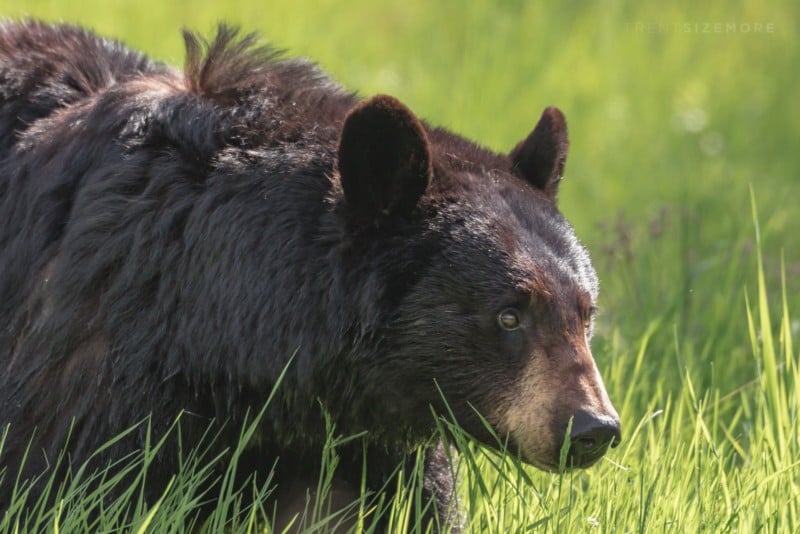
Fall is another great time to see bears, as they’re feeding often to prepare for hibernation. That heavy feeding (up to 20,000 calories per day) requires a lot of hydration, so they can be found traveling near rivers and lakes. After the bison rut in August and September, which naturally causes a lot of bison to die of injuries, you can find bears scavenging on carcasses in an around Lamar and Hayden Valley. In October last year, my workshop group watched a huge grizzly bear feeding on a carcass for hours in the middle of the afternoon, even joined briefly by a lone black wolf. The great thing about the shoulder seasons of April and October is there’s often nobody else around.
In general, you can find bears in the mountains feeding on moths, berries, and whitebark pine nuts, or in the valleys feeding on roots, carrion, and ground squirrels. The area from Hayden Valley and Yellowstone Lake, over Dunraven Pass, and down into Lamar Valley covers the entire range from low to high elevation. Don’t hesitate to take a day searching in areas just outside the official park boundaries as well.
Where to Go
At 2.2 million acres, Yellowstone is the second largest national park in the lower 48 states, making navigation a possibly daunting task for a new visitor. Even though pretty much all of the greater Yellowstone ecosystem (20+ million acres) is considered bear country, there are definitely some places that have higher concentrations.
For black bears, the area from Mammoth Hot Springs to the Tower Falls area is the place to go. This year I’ve photographed at least 16 different black bears within a three-mile stretch near Tower, and even closer to Mammoth. For the most part, these bears have a “home” area of a few square miles but will make their way to slightly higher elevations throughout the summer and fall in search of different foods. A “secret” spot I like to look for black bears is on the Blacktail Plateau Drive, a six-mile one-way road that begins between Mammoth and Tower. Although it’s not guaranteed to see bears here, it’s a nice escape from the main highway.
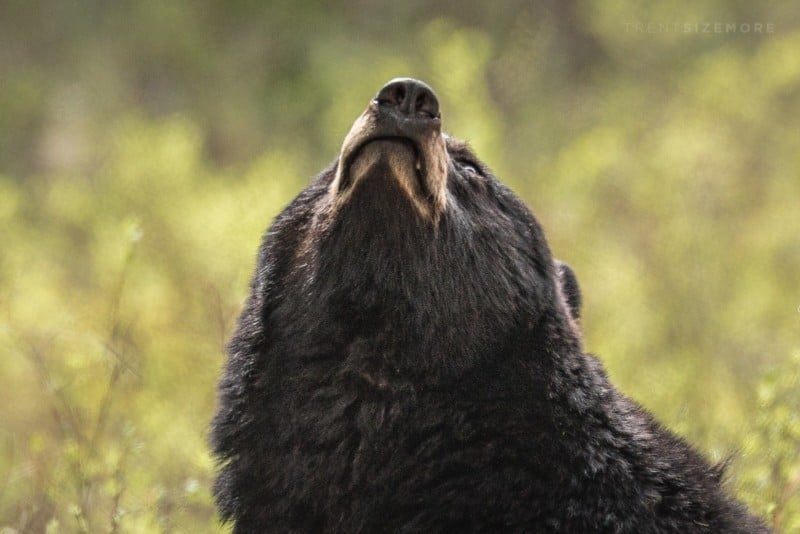
Grizzly bears typically have a larger territory, so they aren’t quite as predictable day to day. As early as February and March, the biggest male grizzly bears start to emerge from their dens. Mothers with cubs will emerge later in April and May. A lot of their diet early in the season consists of winter-killed bison and elk, so they’re going to be concentrated in areas with high populations of those. The area from Old Faithful to Norris to Canyon can be great right when the interior of the park opens in April. Hayden Valley and Lamar Valley are great for grizzlies too, but they tend to be found farther away from the road or on distant mountain ridges.
The valley areas are huge, but it’s still possible to encounter bears that are making their way through and crossing the road. One of my May workshop groups spotted this mother grizzly and her two-year-old cub from pretty far off, but we could see they were heading in the general direction of the road. I chose a pullout down the road and away from the crowd, so we had time to get out and set up tripods alone as the bears approached. After a minute or so of intense photographing I noticed the bears were approaching quicker and heading directly towards us, so we had to get back in the car.
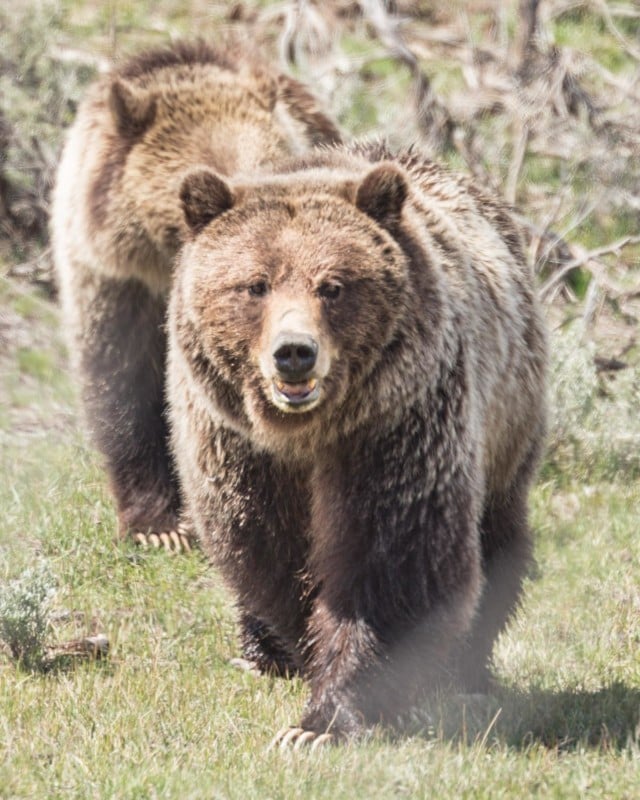
I took this photo from my window, but only because I knew my clients were all getting the same quality images. I don’t worry about getting my own images on a workshop I’m teaching unless my clients insist or they’re happy shooting and I can grab a few quick shots. I spend a lot of time in the field without working, so I can focus on my own photography then. In reality, nobody is asking what’s the best aperture to use when you’re face to face with two huge grizzly bears!
Heat waves can be a factor shooting in the middle of the day, as seen slightly in the photo above. You’ll want to avoid shooting next to a hot car, across the road, or at distances that are just too far. Heat and evaporating moisture from the ground will wreak havoc on image sharpness. I look forward to and prefer to shoot on the cloudy days when possible. Even on freezing winter days, the sun beating down on the snow will cause distortion. Same goes for shooting from inside a warm car when it’s cold outside. Let your lens acclimate to the same temperature from inside to outside when you can.
Shooting While Staying Safe
Most likely someone else has already found a bear before you and there may be a crowd with park rangers present. For photographing bears, this is the best situation. The park rangers work to allow the best experience possible while keeping visitors and bears safe. Although some photographers don’t want to deal with “bear jams” I would NOT recommend hiking in the backcountry for the purpose of finding and photographing bears. Bears found in the backcountry will behave and react very differently from bears hanging out near the road.
You are legally required to remain 100 yards away from bears and wolves, and 25 yards away from everything else (birds included). Currently, the only exception to these rules is photographing from inside your car (parked legally) or in the presence of a park ranger or law enforcement that deems it safe to allow people within 100 yards. As disrespectful visitors continue to illegally approach animals, I imagine soon there may be no way to legally get within 100 yards of a bear.
If you do encounter a bear jam, remember to park legally and completely off the road. Definitely don’t stop in the road and abandon your car like I’ve seen far too often… If you approach and affect any animal’s behavior, even farther than the legal distance, you’re too close. Be respectful to other visitors and don’t make too much noise. Don’t expect to get the best view if others are already there. Wildlife photography should be about photographing animals doing what they do naturally, so don’t do anything in an attempt to make the animal look at your camera. Not only is it illegal in Yellowstone, it’s unethical and disturbs the animal.
Some may wonder if being in close proximity to a bear is healthy for the bear, even if it’s legal. There is a difference between a bear habituated to human presence and one that is conditioned to human food. A habituated bear can utilize great habitat, even if it’s relatively close to civilization and regular traffic. A bear that has obtained food from humans or garbage will regularly come back looking for more. That kind of bear is dangerous and is likely to be relocated or removed. A bear that sees hundreds of visitors per day is not associating them with food, it has just decided over many encounters that humans are not a threat and may keep them safe from larger male bears.
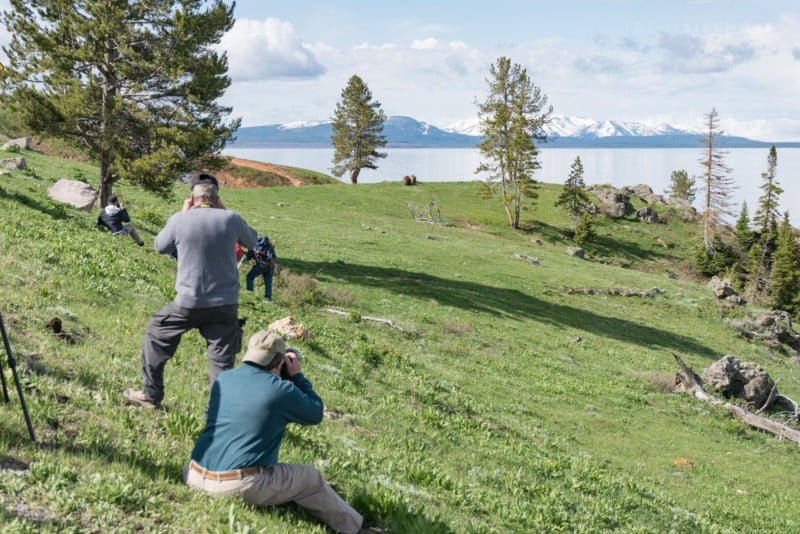
For camera gear, I would recommend being prepared with at least 800mm on a full frame camera or 500mm on a crop sensor camera. I use a Canon 5D Mark IV and a 400mm f/2.8L IS with a 2x extender. Some cheaper lens options are the Sigma/Tamron 150-600mm, Canon 100-400mm or Nikon 200-500mm. Many of the photos I share are still cropped, sometimes significantly for social media.
Unless you can’t physically control your lens, I strongly recommend not using a tripod. They take too much time to set up and are cumbersome to move around for a better composition. I prefer shots taken at the same eye level as my subject, and being a tripod restricts the ability to do that. A monopod is a good compromise if you have a heavy lens, but I personally handhold for 99% of my images.
At most bear encounters a ranger is going to dictate the area you’re allowed to stand, so there’s not always a big range of where you can go for different compositions. The closest shots I’ve taken have been fortunate or surprise encounters where a bear heads towards the car (that I’m sitting in). I thought this bear was on the other side of the river still, so I was quite surprised when it walked right outside my window. I only had time to take a few shots before it was gone.
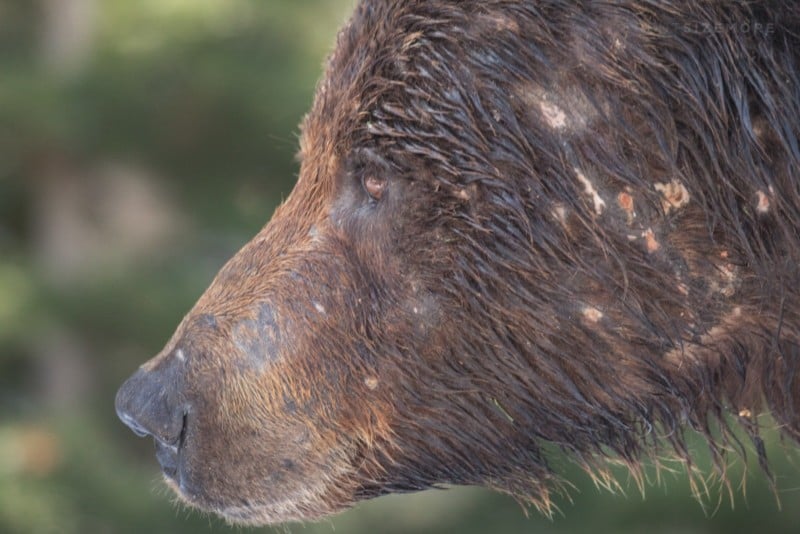
You can’t always get full frame headshots, so it’s important to learn how to photograph bears (and all animals) with a wider view of their environment. This three-year-old grizzly cub and her mother were in the woods feeding on a recent elk calf kill. My workshop client and I waited for hours for a short glimpse of the cub coming down to the water for a swim and a drink. Even though it was June and getting quite warm, these two bears were very visible for several weeks.

The best photographic opportunities come with a lot of time spent in the field and a little bit of luck, but you can help improve your odds by being out at the right time and place. If you visit at these times and drive around these areas for a few hours, you’re almost guaranteed to find a bear.
P.S. If you want to photograph Yellowstone’s bears with a knowledgeable local guide and photography instructor, you may be interested in one of my small group workshops. I also offer a free eBook on wildlife photography and a free online workshop.
About the author: Trent Sizemore is a wildlife photographer, instructor, and tour guide living in West Yellowstone, Montana, just outside Yellowstone Natoinal Park. The opinions in this article are solely those of the author. He has been working and teaching photography as art since 2011, and has had his work published internationally both online and in print. You can find more of Sizemore’s work and writing on his website, Facebook, and Instagram. This article was also published here.